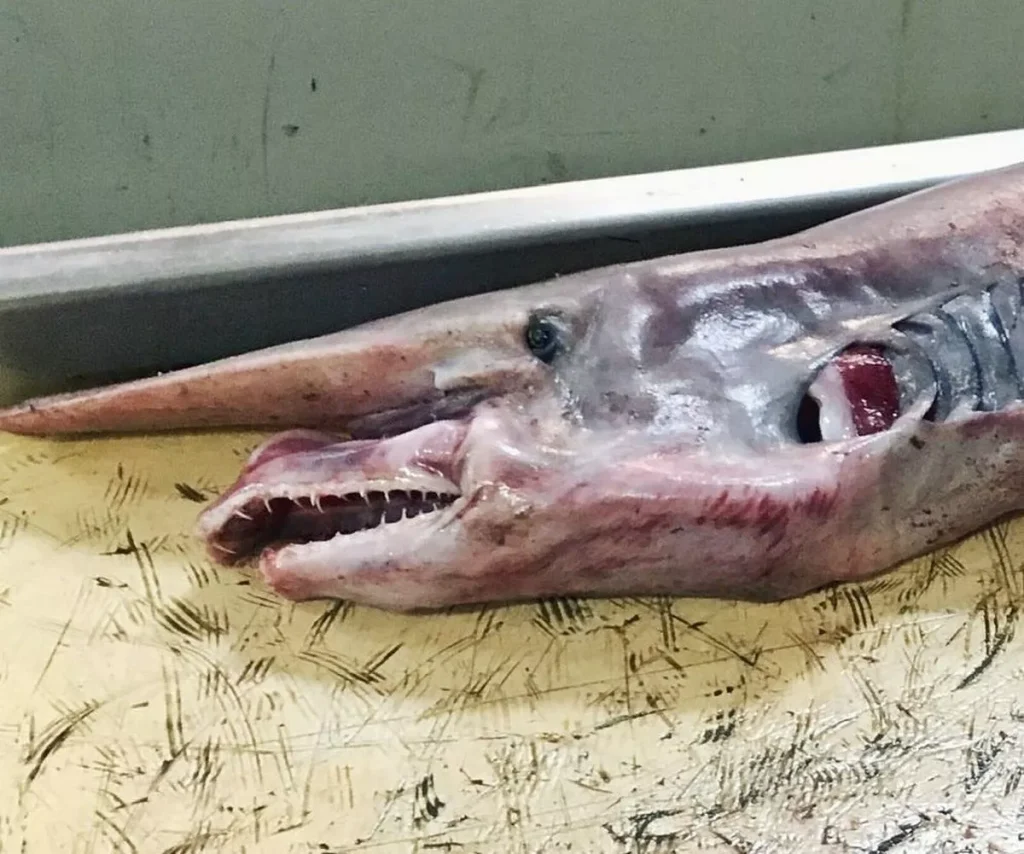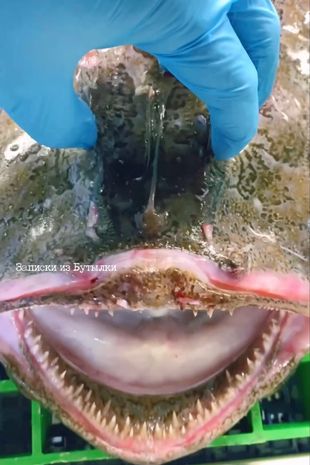Mysterious Deep-Sea Creature with Tentacles Baffles Fisherman

Posted April 13, 2024 by: Admin
Roman Fedortsov, a 39-year-old fisherman from Murmansk, Russia, has once again stunned his followers with his latest deep-sea discovery. Known for his regular deep-sea fishing expeditions and his knack for finding bizarre creatures from the depths, Fedortsov has previously gone viral for capturing an unknown fish with a bloated, puffy mouth, which many online users compared to “bodged lip fillers.” However, his most recent find has left even the most seasoned deep-sea enthusiasts in awe.
In his latest post, shared with his 642,000 social media followers, Fedortsov revealed an “alien from the depths” – an unusual creature with tentacles. The video, which has already racked up 344,000 views and more than 12,000 likes, shows the creature poking its body and tentacles out, almost like a tongue, before receding back into its shell. The appearance and behavior of this deep-sea dweller have sparked a wave of curiosity and speculation among Fedortsov’s followers.

Social media users flocked to the comments section to share their mixed reactions to the peculiar creature. One person described it as a “big a*** barnacle,” while another user jokingly suggested, “With lemon and chili it has to taste really tasty.” However, not everyone was enthusiastic about the prospect of consuming the deep-sea find, with one user stating, “I’d have to be hard-pressed to eat that.” Others expressed their amazement and disbelief, with comments like “What in the!?! Not in this hundredth dimension of the grey side of the matrix. No,” and “Scary, turn it off.”
Roman Fedortsov’s deep-sea fishing expeditions have yielded a plethora of bizarre and fascinating creatures. In addition to the recent “alien from the depths,” the fisherman, who also catches cod, haddock, and mackerel, has previously discovered a fish wearing lipstick, one with “cheeseburger” teeth, and another that resembled a baby dragon. These unusual finds have garnered significant attention on social media, showcasing the incredible diversity of life that exists in the deep ocean.

The challenges of identifying deep-sea creatures are well-known among experts, as many species have unique adaptations and have been subject to limited research. A recent case involving the “Salish sea monster,” discovered by Eric Evans near the Elwah River in Washington state, USA, highlights this difficulty. Despite consulting with wildlife experts and former colleagues at the Olympic Coast National Marine Sanctuary, Evans was unable to obtain a clear consensus on the creature’s identity. The Washington Department of Fish and Wildlife concluded that the remains were too decomposed to identify, while Casey Cook, director of the Marine Life Center at Bellingham, noted that some parts of the body were characteristic of the shark family, while others were more typical of a seal or whale.

The deep sea remains one of the least explored and understood environments on Earth, with estimates suggesting that up to two-thirds of marine species are yet to be discovered. The creatures that inhabit these extreme depths have evolved unique adaptations to survive in the cold, dark, and high-pressure conditions, often resulting in bizarre and alien-like appearances. Studying these deep-sea organisms is crucial for understanding marine ecosystems, as they play vital roles in nutrient cycling, carbon sequestration, and the overall health of our oceans. Moreover, the deep sea holds the potential for groundbreaking scientific discoveries, including new species, novel biomolecules, and insights into the origins of life on Earth.
Fishermen like Roman Fedortsov play a significant role in contributing to our knowledge of deep-sea creatures. By sharing their discoveries on social media platforms, they help raise awareness about the incredible diversity of marine life and spark public interest in the mysteries of the deep ocean. This increased awareness can lead to greater support for marine conservation efforts and scientific research, as people become more invested in protecting the fascinating and often bizarre creatures that inhabit the depths.

The impact of social media on marine life awareness cannot be overstated. Platforms like those used by Roman Fedortsov allow people from all walks of life to engage with the wonders of the deep sea, fostering a sense of connection and curiosity about these little-known ecosystems. As more people become aware of the incredible diversity of life in the deep ocean, there is a growing potential for increased public interest in marine conservation and research. This heightened awareness can translate into greater support for policies and initiatives aimed at protecting deep-sea habitats and the creatures that call them home.
Advancements in technology are paving the way for future deep-sea exploration and research. Innovations in robotics, sensors, and imaging systems are allowing scientists to probe the depths like never before, revealing new insights into the structure and function of deep-sea ecosystems. Autonomous underwater vehicles (AUVs) and remotely operated vehicles (ROVs) equipped with high-resolution cameras and sampling tools are enabling researchers to collect data and specimens from previously inaccessible regions of the deep ocean. Additionally, the development of new genetic sequencing techniques is facilitating the identification and study of deep-sea organisms, even from small tissue samples. As these technologies continue to evolve, our understanding of the deep sea and its inhabitants will undoubtedly grow, leading to new discoveries and a greater appreciation for the importance of these hidden realms.

However, deep-sea exploration and research are not without their challenges. The extreme conditions of the deep ocean, including high pressure, low temperatures, and the absence of sunlight, make it difficult and expensive to conduct studies in these environments. Moreover, the vastness of the deep sea means that much of it remains unexplored, with many species and ecosystems yet to be discovered. To overcome these challenges, international collaboration and funding for marine research are essential. By pooling resources and expertise, scientists from around the world can work together to unravel the mysteries of the deep sea and develop strategies for conserving its unique biodiversity.
The discovery of the mysterious deep-sea creature with tentacles by Roman Fedortsov serves as a reminder of the incredible diversity and mystery that exists in the depths of our oceans. As we continue to explore and study these hidden realms, we are sure to uncover more bizarre and fascinating creatures that challenge our understanding of life on Earth. The ongoing fascination with deep-sea organisms, as evidenced by the viral impact of Fedortsov’s findings, highlights the importance of continued exploration and conservation efforts. By supporting marine research and raising awareness about the wonders of the deep sea, we can work towards a future in which these incredible ecosystems are better understood, appreciated, and protected for generations to come.

















